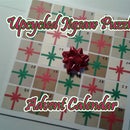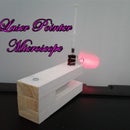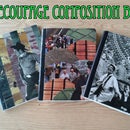Introduction: A Lapful of Scrap- a Lap Steel Guitar Made From Recycled Materials
The lap steel guitar has deep roots. The basic principal is simple- a string is stretched tight and a heavy, hard object is used to slide along the string while the string is plucked to produce sounds. An early ancestor was the diddly bo, an expedient rural folk instrument comprised of a wire stretched tight across a wall or fence that was played with a stick that was used to slap the wire and operate as a simple slide. A much more refined version is the Dobro, or resonator guitar, a key component of American mountain music. When folks left the mountains for work in the cities the Dobro became the blues slide electric guitar of Chicago, the pedal steel of Nashville and somehow the slack key guitar of Hawaii..
This family of instruments give the player a lot of variety of musical expression. From the high lonesome sound of bluegrass to the soothing strains of Aloha Oe. From the smooth playing of the blues to the clean, shimmering sound of country music's pedal steel, string instruments played with a slide produce a lot of different sounds. First of all the slide allows the music to have a slippery, smooth transition from note to note. It can be moved back and forth very fast to create tremolo and vibrato effects. The slide can also be pressed down to increase string tension for even more expression. The slide can also be lifted and dropped slightly on the strings as you play for a percussive, rhythmic effect. By tuning the strings to an open chord structure the player can play chords by barring the strings with the slide and strumming or picking simple arpeggio patterns. Add an external effects processor to the sound and the sky is the limit.
For such an expressive instrument, a basic lap steel is easy and cheap to make. The basis for this particular project is a scrap of 1x4 select pine lumber, some scraps of aluminum angle, some recycled tuners from an old guitar, a scrap of PVC fence post and some recycled electronics. I had all the parts for this laying around my shop, so this project cost nothing and it turned out really cool.
Step 1: A Lap Steel Slide Guitar From Scrap- the Lapful of Scrap
This lap steel will basically be a set of strings suspended about an inch above a board with a simple bridge. I used a scrap of select pine 1x4 that was about three feet long. The design of this type of instrument is very forgiving because there are no frets; it's just a set of suspended strings. When you press a guitar string down to make a note, the pressed string goes across the thin metal fret to play the note, This means that the frets have to be put in very precise positions to make proper notes. The lap steel requires the player to 'find' the notes as they play. This allows us to skip the hardest part of making a stringed instrument and get down to getting down.
The dimensions are not as precise as a guitar, but I do want to base the over all string length on a real-life guitar. I measured my B.C. Rich Warlock from the bridge to the second fret and got 23 1/16 inches. This fit my 1x4x36 piece of wood with plenty of room for the strings and hardware. The reason I used this length is that even though I won't be adding frets, I'll want to add some guide marks to make it easier to find notes. Later in the build I'll use the guitar's fret spacing as a guide for these marks.
Another concern is the wood's thickness. The tuners I have are just long enough to protrude through the 1x4's 3/4 inch thickness. I want to make this design as simple as possible, so this is good.
Since the lap steel is played flat with a slide and doesn't need to be fingered on a fretboard, it can have more strings than a regular guitar and they can be spaced further apart. This allows for plenty of special tunings and note intervals. The tuning of a pedal steel can be very complex and customized to the player. I want a simple instrument. I have four tuning machines salvaged from an old guitar, so I decided that a four string instrument would be fine. This also means less tension than an instrument with more strings, so the softer, thinner pine I'm using won't be an issue. There's room to add two more tuners and strings later if I want, but I'd probably want to add some reinforcement to the bottom with the extra tension.
Once I had the basic design and dimensions it was time to lay out the board. I used a few handy curves to trace a basic head stock shape and cut it out with a jigsaw. I gave it a good sanding to smooth down the edges and took it back to the bench to lay out the hardware.
First I laid out the tuning machines and drilled out the holes for the tuner shafts. Next I temporarily installed the tuner bushings and the tuners so that I could install the tuning machine screws. When all the holes were drilled and the tuners were installed, I removed it all and put it aside for later.
Next I made and installed the nut and the bridge. I cut them from some scrap aluminum angle and cleaned them up with a file. I marked and drilled some mounting holes. First I marked and installed the nut. This holds the strings above the 'fret board' near the headstock. I used two recycled screws to install the nut. When using recycled or reclaimed screws and hardware, it takes a bit more planning to insure you have enough for the whole job. I had eight decent chrome wood screws that would work nice for the nut, bridge and plastic cover.
Now I measured 23 1/16 inches and put the bridge there as a guide to mark the screw holes and drill them. I'm going to use a piece of PVC fence post scrap to make a cover/hand rest, so this was taken into consideration for the bottom end layout. I also marked four holes for the strings to go through and drilled them as well. With all the hardware taken into account, I gave it all a good sanding to prep it for primer and paint.
Step 2: Putty and Paint...
It's amazing what a coat of cheap paint can do for a project with a little creativity. My dad, a commercial painter who just retired this month, once told me 'Putty and paint will do what carpenter caint'. Fine woodworking is only a necessity if you want a fine wood finish. I hate extensive sanding, so I tend to go for finishes that hide flaws like spray paint in multiple layer and textures. Since I'm painting this one, I didn't go overboard on the sanding. I'm going for quick, cheap and repeatable.
There are a confusing number of finishing options for something like this. I bought a case of glitter paint from one of the big box stores on holiday clearance last year so I decided to go with gold glitter over a silver metallic base. I started with a Rustoleum Industrial aluminum paint and built up several thin coats. Metallics dry very quickly in thin coats, so this part goes fast. Give the whole thing a light sanding before the final coat.
When the silver under coat dried, I built up several layers of the gold glitter. This is basically tiny bits of glitter in a clear coat. It has to be shaken well and often, and applied in thin coats. It has to be allowed to dry between coats so this part takes patience. It took 7 coats to cover the instrument evenly. It is mostly covered in gold with just a hint of silver showing through.
When the glitter was dry I gave it a few thin coats of clear coat. This helps seal in the glitter and smooth the surface a bit. Now I let it dry completely in front of a heater.
Step 3: Wiring the Pickup
The pickup for the lap steel is based on a piezo disk. Piezo discs are super useful and can be found in old smoke detectors, alarm clocks and other things that make annoying beeps, chirps and alarms. A piezo disk consists of a quartz crystal sliver between two metal plates. When a current is fed through a piezo disk it vibrates, making sound. A piezo can also be used to detect vibrations like a microphone. Piezos take a high impedance and produce a weak signal. for a full frequency response the piezo's signal needs to go through a preamp buffer. I can skip the buffer for two reasons- this is primarily a lead instrument with a higher frequency range and I'm using an external preamp effects processor.
The piezo disk I used came from a discarded Rock Band video game controller. It had four disks with some handy mounting hardware and silicone mounting pads.
The 'circuit' couldn't be any simpler- With a 50k pot laying on the table shaft up, connect the ground of the piezo to the left side lug and the other lead to the right side. Connect a 1/4 inch mono audio output jack's ground to the left hand lug and the other lead to the middle lug of the pot. Finally, connect a ground lead to ground the lap steel's strings and hardware. Since the piezo I used had a nice two pin connector, I made a connector out of header pins for easy disassembly. The pot and audio jack came from an old mixer I disassembled last year and the piezo was from a smoke detector, so the electronics cost me nothing.
I dug through a few screw jars until I found three nice soft silicone washers. I used two washers for each bridge mounting screw and the third sandwiched the disk in between the bridge and the body of the lap steel. I screwed in an eye screw and tied the piezo wires around it to relieve stress. Piezos have very weak connections! I put the ground wire from the pot and jack under one of the bridge mounting screws and tightened them down.
Now I drilled holes in the plastic cover for the pot, output jack and mounting screws. I installed them and screwed the cover to the lap steel's body.
Time to string it up and rock out.
Step 4: There's a Few Strings Attached...
Now I installed some strings. After thirty years of playing and collecting guitars I've ended up with lots of partial packs of strings. This gave me a lot of options for set up and tuning. After a little trial and error I decided on E-G-C-D# with a .011, .012, .015 and .016 string. These are smooth strings so there won't be any of the buzz or scrape from wound strings. If I wanted to try a lower tuning later I'd get flat wound jazz strings for a smoother sound. This gives a C major chord on the lower three strings and a C minor on the upper three strings. This also gives some cool sounding intervals between pairs of strings. This will make more sense in the video.
I started by pushing steel grommets into the tops and bottoms of the four holes on the bottom end of the instrument. This holds the string end in place on the bottom and protects the wood where the string comes out on the top. The strings went in through the back, across the bridge and nut and into the tuner shafts. I plugged it into a tuner and that was that- it worked and sounded just fine!
Step 5: Finishing Details and Rocking Out
After I strung it up and made sure it worked I took the strings loose to mark the 'frets'. These are marks to help me find the right note positions. I put a piece of blue tape along the side of my guitar's neck. Since I based the lap steel's dimensions on the second fret of the guitar, I marked each fret starting with the second one. I marked down to the 18th fret.
I carefully removed the tape from the guitar neck and put it on the side of the lap steel, aligning the second fret mark on the tape with the edge of the nut. I used a carpenter's tri-square and a paint pen to mark all the fret positions. Next I added self adhesive jewels at the fretboard inlay points to make finding note positions easier. I replaced the strings and that was it.
The lap steel was ready to play but something was bugging me. The glitter looked really flashy but the PVC cover was kind of dull. Since everything looks better with a sticker on it, I went to my sticker drawer and found a cool yellow and green flying monster that matched the glitter quite well. Now it was done.
Step 6: Sliding Off Into the Sunset
So now I have a lap steel slide guitar, but what do I play it with? Anything round, smooth, hard and straight will work. I've used chromed deep-well sockets. A thin long jar is a good choice. When I used to play a Dobro I had a nice, heavy chrome slide with a nice rounded end that allowed it to slide on and off of the strings. I've played impromptu slide guitar with beer bottles, Zippos and silverware. Now I'm using a bottle neck that's been cut and polished by my friend Gordy, a glass artist and my lead junk scout.
Another useful slide accessory is a few finger picks. These clip onto your fingers and thumb to aid picking in the flat position. They come in all kinds of different designs. I still have a few from my Dobro playing days. I've lost a couple of fingertips since then, so my picking style has changed a lot. I tend to just use my ring finger pad and thumb nail now to pluck double strings or play arpeggios.
Friction is your enemy! I keep the strings lubed with WD40 on the upper 3/4. Usually with a guitar this is a no-no, but with no fancy rosewood fingerboard and no finger contact, it's a lot cheaper than the stuff they sell at the music store. It also really helps to keep your slide clean and lubed.I leave the plucking/strumming area bare because I hate having greasy fingers. I give that area a light coating of wax and wipe it down with a soft rag. Do not use water based lubricant on your instruments. It will dry out and gum up your strings and it will actually cause rust and oxidation.
The most important accessory for a lap steel like this is a guitar effect or preamp. The signal from the piezo is weak and without a buffer you'll have to turn the amp way up. By using an effect, it acts as a preamp and raises the output level. I use a Korg Tone Works Pandora for guitar. It's a really good sounding all-in-one digital effects processor and amp modeller. If you wanted to build a lap steel with a very low bass frequency you would have to use a buffer as the high impedance needs of the piezo affect the frequency output without one.
OK- so there's nothing left but to show you a video of the Lapful of Scrap in action. I'm playing through the Korg Pandora effects processor and the Recyclone rotary amp. Enjoy-
lapfulofscrap from chuck stephens on Vimeo.

Participated in the
Guerilla Design Contest

Participated in the
DIY Audio and Music Contest













